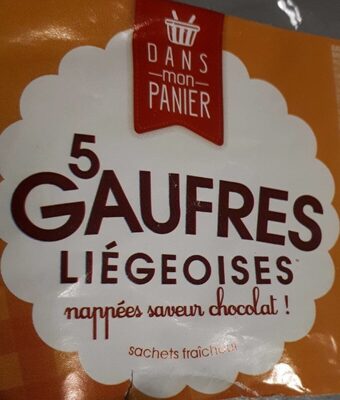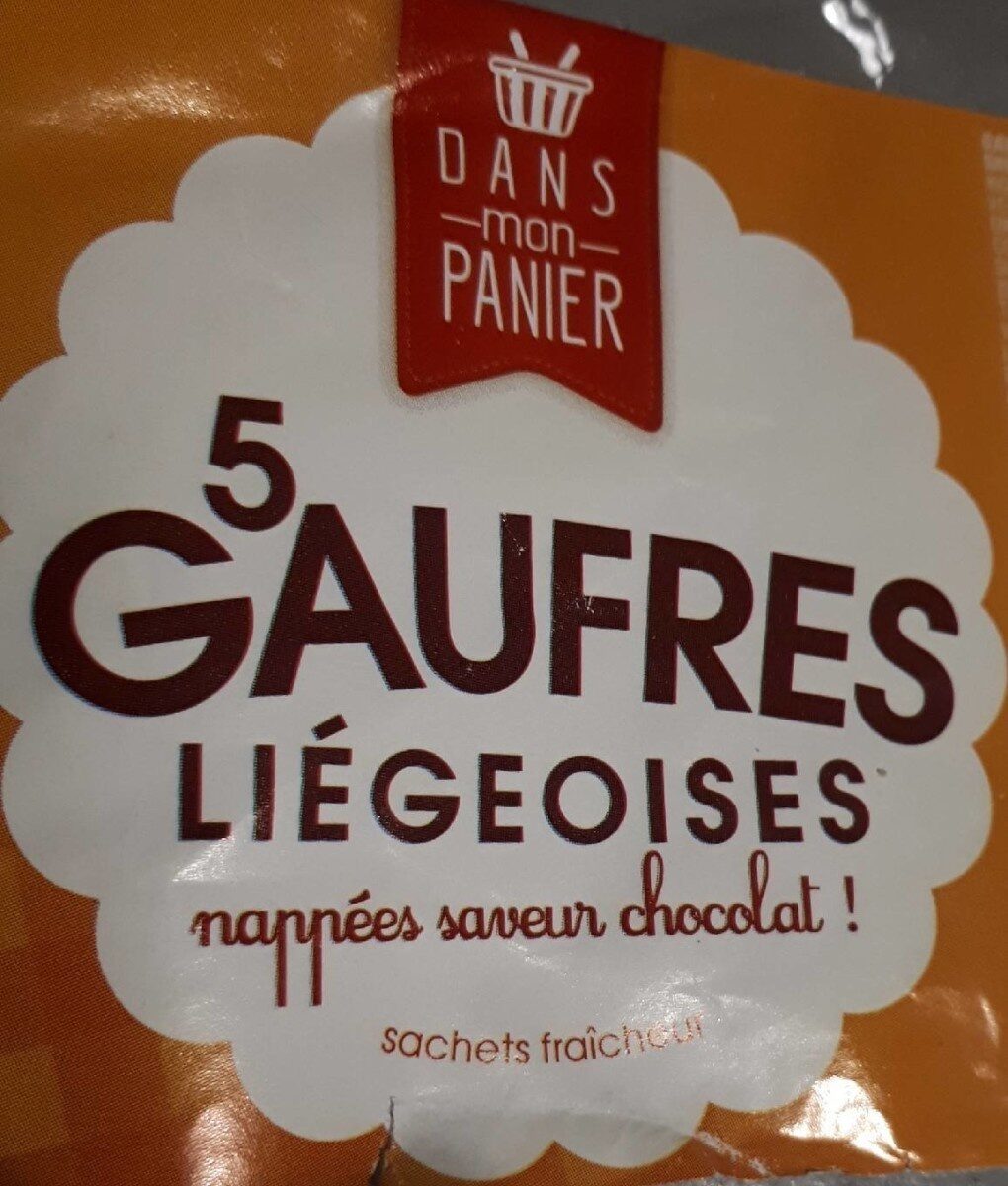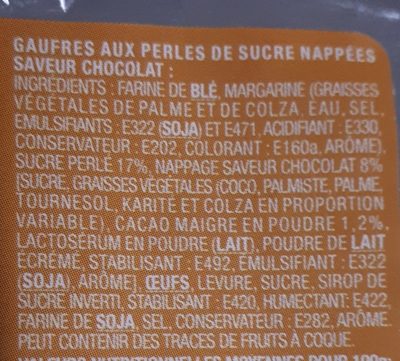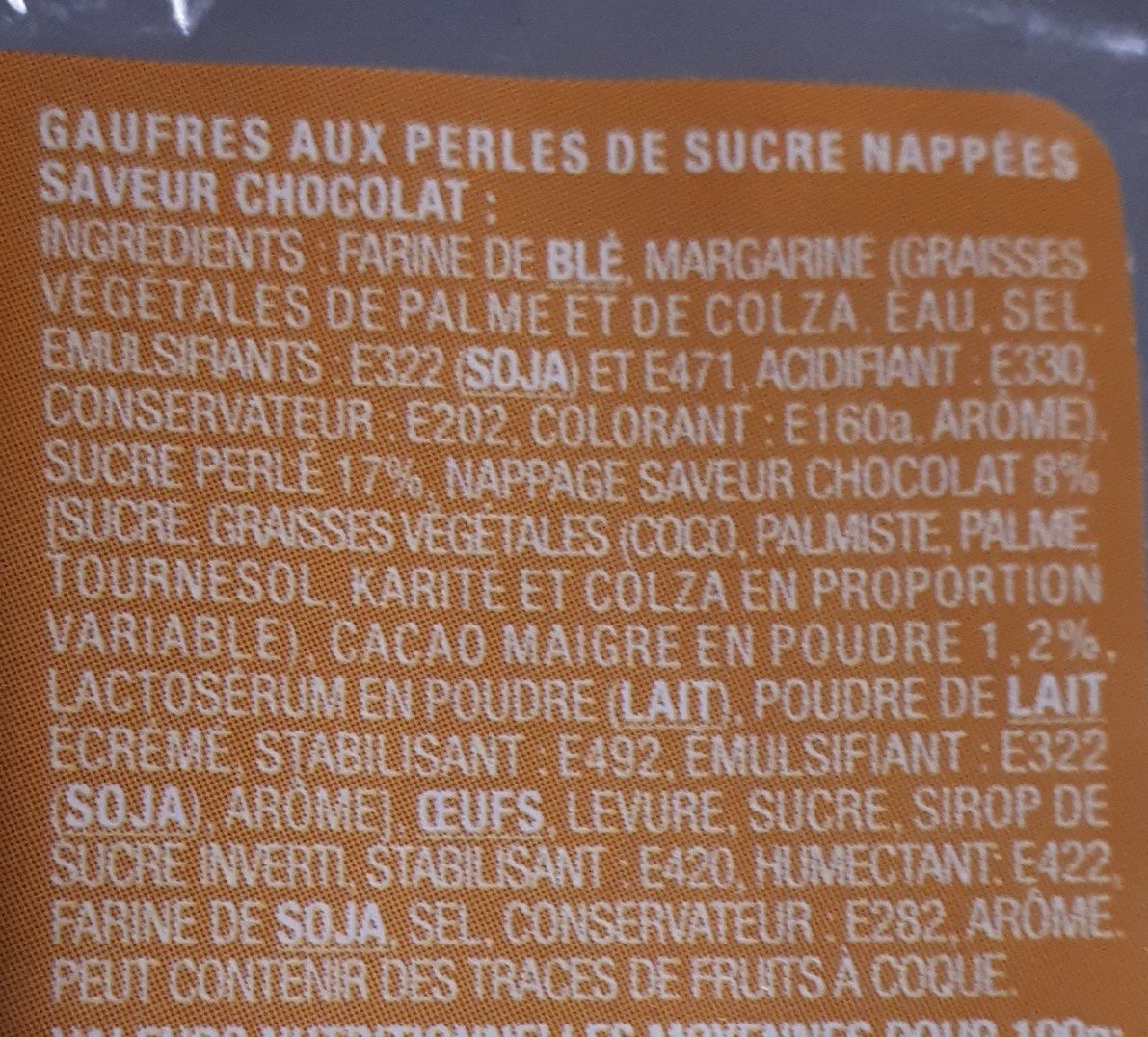Help us make food transparency the norm!
As a non-profit organization, we depend on your donations to continue informing consumers around the world about what they eat.
The food revolution starts with you!
Gaufres liégeoises - Dans Mon Panier - 300 g
Gaufres liégeoises - Dans Mon Panier - 300 g
This product page is not complete. You can help to complete it by editing it and adding more data from the photos we have, or by taking more photos using the app for Android or iPhone/iPad. Thank you!
×
Some of the data for this product has been provided directly by the manufacturer Carrefour.
Barcode: 3513851556093 (EAN / EAN-13)
Common name: Gaufres Liégeoises Nappées Saveur Chocolat
Quantity: 300 g
Brands: Dans Mon Panier
Categories: Snacks, Sweet snacks, Biscuits and cakes, Pastries, Waffles, Plain Brussels-style soft waffle
Labels, certifications, awards:
Green Dot
Stores: Intermarché Express, carrefour.fr
Countries where sold: France
Matching with your preferences
Health
Ingredients
-
46 ingredients
: Farine de blé, Margarine (graisses végétales de palme et de colza, eau, sel, émulsifiants : E322 (soja) et E471, acidifiant : E330, conservateur : E202, colorant : E160a, arôme), sucre perlé 17%, nappage saveur chocolat 8 % (sucre, graisses végétales (coco, palmiste, palme, tournesol, karité et colza en proportion variable), cacao maigre en poudre 1,2 %, lactosérum en poudre (lait), poudre de lait écrémé, stabilisant : E492, émulsifiant : E322 (soja), arôme), œufs, levure, sucre, sirop de sucre inverti, stabilisant : E420, humectant : E422, farine de soja, sel, conservateur : E282, arômeAllergens: Eggs, Gluten, Milk, SoybeansTraces: Nuts
Food processing
-
Ultra processed foods
Elements that indicate the product is in the 4 - Ultra processed food and drink products group:
- Additive: E160a - Carotene
- Additive: E322 - Lecithins
- Additive: E420 - Sorbitol
- Additive: E422 - Glycerol
- Additive: E471 - Mono- and diglycerides of fatty acids
- Additive: E492 - Sorbitan tristearate
- Ingredient: Colour
- Ingredient: Emulsifier
- Ingredient: Flavouring
- Ingredient: Humectant
- Ingredient: Invert sugar
- Ingredient: Whey
Food products are classified into 4 groups according to their degree of processing:
- Unprocessed or minimally processed foods
- Processed culinary ingredients
- Processed foods
- Ultra processed foods
The determination of the group is based on the category of the product and on the ingredients it contains.
Additives
-
E160a - Carotene
Carotene: The term carotene -also carotin, from the Latin carota, "carrot"- is used for many related unsaturated hydrocarbon substances having the formula C40Hx, which are synthesized by plants but in general cannot be made by animals -with the exception of some aphids and spider mites which acquired the synthesizing genes from fungi-. Carotenes are photosynthetic pigments important for photosynthesis. Carotenes contain no oxygen atoms. They absorb ultraviolet, violet, and blue light and scatter orange or red light, and -in low concentrations- yellow light. Carotenes are responsible for the orange colour of the carrot, for which this class of chemicals is named, and for the colours of many other fruits, vegetables and fungi -for example, sweet potatoes, chanterelle and orange cantaloupe melon-. Carotenes are also responsible for the orange -but not all of the yellow- colours in dry foliage. They also -in lower concentrations- impart the yellow coloration to milk-fat and butter. Omnivorous animal species which are relatively poor converters of coloured dietary carotenoids to colourless retinoids have yellowed-coloured body fat, as a result of the carotenoid retention from the vegetable portion of their diet. The typical yellow-coloured fat of humans and chickens is a result of fat storage of carotenes from their diets. Carotenes contribute to photosynthesis by transmitting the light energy they absorb to chlorophyll. They also protect plant tissues by helping to absorb the energy from singlet oxygen, an excited form of the oxygen molecule O2 which is formed during photosynthesis. β-Carotene is composed of two retinyl groups, and is broken down in the mucosa of the human small intestine by β-carotene 15‚15'-monooxygenase to retinal, a form of vitamin A. β-Carotene can be stored in the liver and body fat and converted to retinal as needed, thus making it a form of vitamin A for humans and some other mammals. The carotenes α-carotene and γ-carotene, due to their single retinyl group -β-ionone ring-, also have some vitamin A activity -though less than β-carotene-, as does the xanthophyll carotenoid β-cryptoxanthin. All other carotenoids, including lycopene, have no beta-ring and thus no vitamin A activity -although they may have antioxidant activity and thus biological activity in other ways-. Animal species differ greatly in their ability to convert retinyl -beta-ionone- containing carotenoids to retinals. Carnivores in general are poor converters of dietary ionone-containing carotenoids. Pure carnivores such as ferrets lack β-carotene 15‚15'-monooxygenase and cannot convert any carotenoids to retinals at all -resulting in carotenes not being a form of vitamin A for this species-; while cats can convert a trace of β-carotene to retinol, although the amount is totally insufficient for meeting their daily retinol needs.Source: Wikipedia
-
E202 - Potassium sorbate
Potassium sorbate (E202) is a synthetic food preservative commonly used to extend the shelf life of various food products.
It works by inhibiting the growth of molds, yeast, and some bacteria, preventing spoilage. When added to foods, it helps maintain their freshness and quality.
Some studies have shown that when combined with nitrites, potassium sorbate have genotoxic activity in vitro. However, potassium sorbate is generally recognized as safe (GRAS) by regulatory authorities.
-
E282 - Calcium propionate
Calcium propanoate: Calcium propanoate or calcium propionate has the formula Ca-C2H5COO-2. It is the calcium salt of propanoic acid.Source: Wikipedia
-
E322 - Lecithins
Lecithins are natural compounds commonly used in the food industry as emulsifiers and stabilizers.
Extracted from sources like soybeans and eggs, lecithins consist of phospholipids that enhance the mixing of oil and water, ensuring smooth textures in various products like chocolates, dressings, and baked goods.
They do not present any known health risks.
-
E330 - Citric acid
Citric acid is a natural organic acid found in citrus fruits such as lemons, oranges, and limes.
It is widely used in the food industry as a flavor enhancer, acidulant, and preservative due to its tart and refreshing taste.
Citric acid is safe for consumption when used in moderation and is considered a generally recognized as safe (GRAS) food additive by regulatory agencies worldwide.
-
E420 - Sorbitol
Sorbitol: Sorbitol --, less commonly known as glucitol --, is a sugar alcohol with a sweet taste which the human body metabolizes slowly. It can be obtained by reduction of glucose, which changes the aldehyde group to a hydroxyl group. Most sorbitol is made from corn syrup, but it is also found in nature, for example in apples, pears, peaches, and prunes. It is converted to fructose by sorbitol-6-phosphate 2-dehydrogenase. Sorbitol is an isomer of mannitol, another sugar alcohol; the two differ only in the orientation of the hydroxyl group on carbon 2. While similar, the two sugar alcohols have very different sources in nature, melting points, and uses.Source: Wikipedia
-
E422 - Glycerol
Glycerol: Glycerol -; also called glycerine or glycerin; see spelling differences- is a simple polyol compound. It is a colorless, odorless, viscous liquid that is sweet-tasting and non-toxic. The glycerol backbone is found in all lipids known as triglycerides. It is widely used in the food industry as a sweetener and humectant and in pharmaceutical formulations. Glycerol has three hydroxyl groups that are responsible for its solubility in water and its hygroscopic nature.Source: Wikipedia
-
E471 - Mono- and diglycerides of fatty acids
Mono- and diglycerides of fatty acids (E471), are food additives commonly used as emulsifiers in various processed foods.
These compounds consist of glycerol molecules linked to one or two fatty acid chains, which help stabilize and blend water and oil-based ingredients. E471 enhances the texture and shelf life of products like margarine, baked goods, and ice cream, ensuring a smooth and consistent texture.
It is generally considered safe for consumption within established regulatory limits.
-
E492 - Sorbitan tristearate
Sorbitan tristearate: Sorbitan tristearate is a nonionic surfactant. It is variously used as a dispersing agent, emulsifier, and stabilizer, in food and in aerosol sprays. As a food additive, it has the E number E492. Brand names for polysorbates include Alkest, Canarcel, and Span. The consistency of sorbitan tristearate is waxy; its color is light cream to tan.Source: Wikipedia
Ingredients analysis
-
Palm oil
Ingredients that contain palm oil: Palm fat, Palm kernel fat, Palm fat
-
Non-vegan
Non-vegan ingredients: Whey powder, Skimmed milk powder, EggSome ingredients could not be recognized.
We need your help!
You can help us recognize more ingredients and better analyze the list of ingredients for this product and others:
- Edit this product page to correct spelling mistakes in the ingredients list, and/or to remove ingredients in other languages and sentences that are not related to the ingredients.
- Add new entries, synonyms or translations to our multilingual lists of ingredients, ingredient processing methods, and labels.
If you would like to help, join the #ingredients channel on our Slack discussion space and/or learn about ingredients analysis on our wiki. Thank you!
-
Vegetarian status unknown
Unrecognized ingredients: Margarine, fr:nappage-saveur-chocolatSome ingredients could not be recognized.
We need your help!
You can help us recognize more ingredients and better analyze the list of ingredients for this product and others:
- Edit this product page to correct spelling mistakes in the ingredients list, and/or to remove ingredients in other languages and sentences that are not related to the ingredients.
- Add new entries, synonyms or translations to our multilingual lists of ingredients, ingredient processing methods, and labels.
If you would like to help, join the #ingredients channel on our Slack discussion space and/or learn about ingredients analysis on our wiki. Thank you!
-
Details of the analysis of the ingredients
We need your help!
Some ingredients could not be recognized.
We need your help!
You can help us recognize more ingredients and better analyze the list of ingredients for this product and others:
- Edit this product page to correct spelling mistakes in the ingredients list, and/or to remove ingredients in other languages and sentences that are not related to the ingredients.
- Add new entries, synonyms or translations to our multilingual lists of ingredients, ingredient processing methods, and labels.
If you would like to help, join the #ingredients channel on our Slack discussion space and/or learn about ingredients analysis on our wiki. Thank you!
: Farine de _blé_, Margarine (graisses végétales de palme, graisses végétales de colza, eau, sel, émulsifiants (e322), e471, acidifiant (e330), conservateur (e202), colorant (e160a), arôme), sucre perlé 17%, nappage saveur chocolat 8% (sucre, graisses végétales de coco, graisses végétales de palmiste, graisses végétales de palme, graisses végétales de tournesol, graisses végétales de karité, graisses végétales de colza, cacao maigre en poudre 1.2%, lactosérum en poudre, poudre de _lait_ écrémé, stabilisant (e492), émulsifiant (e322), arôme), _œufs_, levure, sucre, sirop de sucre inverti, stabilisant (e420), humectant (e422), farine de _soja_, sel, conservateur (e282), arôme- Farine de _blé_ -> en:wheat-flour - vegan: yes - vegetarian: yes - ciqual_proxy_food_code: 9410
- Margarine -> en:margarine
- graisses végétales de palme -> en:palm-fat - vegan: yes - vegetarian: yes - from_palm_oil: yes - ciqual_proxy_food_code: 16129
- graisses végétales de colza -> en:colza-oil - vegan: yes - vegetarian: yes - from_palm_oil: no - ciqual_food_code: 17130
- eau -> en:water - vegan: yes - vegetarian: yes - ciqual_food_code: 18066
- sel -> en:salt - vegan: yes - vegetarian: yes - ciqual_food_code: 11058
- émulsifiants -> en:emulsifier
- e322 -> en:e322 - vegan: maybe - vegetarian: maybe
- e471 -> en:e471 - vegan: maybe - vegetarian: maybe - from_palm_oil: maybe
- acidifiant -> en:acid
- e330 -> en:e330 - vegan: yes - vegetarian: yes
- conservateur -> en:preservative
- e202 -> en:e202 - vegan: yes - vegetarian: yes
- colorant -> en:colour
- e160a -> en:e160a - vegan: maybe - vegetarian: maybe - from_palm_oil: maybe
- arôme -> en:flavouring - vegan: maybe - vegetarian: maybe
- sucre perlé -> en:nib-sugar - vegan: yes - vegetarian: yes - ciqual_proxy_food_code: 31016 - percent: 17
- nappage saveur chocolat -> fr:nappage-saveur-chocolat - percent: 8
- sucre -> en:sugar - vegan: yes - vegetarian: yes - ciqual_proxy_food_code: 31016
- graisses végétales de coco -> en:coconut-oil - vegan: yes - vegetarian: yes - from_palm_oil: no - ciqual_food_code: 16040
- graisses végétales de palmiste -> en:palm-kernel-fat - vegan: yes - vegetarian: yes - from_palm_oil: yes
- graisses végétales de palme -> en:palm-fat - vegan: yes - vegetarian: yes - from_palm_oil: yes - ciqual_proxy_food_code: 16129
- graisses végétales de tournesol -> en:sunflower-oil - vegan: yes - vegetarian: yes - from_palm_oil: no - ciqual_food_code: 17440
- graisses végétales de karité -> en:shea-butter - vegan: yes - vegetarian: yes - from_palm_oil: no
- graisses végétales de colza -> en:colza-oil - vegan: yes - vegetarian: yes - from_palm_oil: no - ciqual_food_code: 17130
- cacao maigre en poudre -> en:fat-reduced-cocoa-powder - vegan: yes - vegetarian: yes - ciqual_food_code: 18100 - percent: 1.2
- lactosérum en poudre -> en:whey-powder - vegan: no - vegetarian: maybe
- poudre de _lait_ écrémé -> en:skimmed-milk-powder - vegan: no - vegetarian: yes - ciqual_food_code: 19054
- stabilisant -> en:stabiliser
- e492 -> en:e492 - vegan: maybe - vegetarian: maybe
- émulsifiant -> en:emulsifier
- e322 -> en:e322 - vegan: maybe - vegetarian: maybe
- arôme -> en:flavouring - vegan: maybe - vegetarian: maybe
- _œufs_ -> en:egg - vegan: no - vegetarian: yes - ciqual_food_code: 22000
- levure -> en:yeast - vegan: yes - vegetarian: yes
- sucre -> en:sugar - vegan: yes - vegetarian: yes - ciqual_proxy_food_code: 31016
- sirop de sucre inverti -> en:invert-sugar-syrup - vegan: yes - vegetarian: yes
- stabilisant -> en:stabiliser
- e420 -> en:e420 - vegan: yes - vegetarian: yes
- humectant -> en:humectant
- e422 -> en:e422 - vegan: maybe - vegetarian: maybe
- farine de _soja_ -> en:soya-flour - vegan: yes - vegetarian: yes - ciqual_food_code: 20900
- sel -> en:salt - vegan: yes - vegetarian: yes - ciqual_food_code: 11058
- conservateur -> en:preservative
- e282 -> en:e282 - vegan: yes - vegetarian: yes
- arôme -> en:flavouring - vegan: maybe - vegetarian: maybe
Nutrition
-
Bad nutritional quality
⚠ ️Warning: the amount of fruits, vegetables and nuts is not specified on the label, it was estimated from the list of ingredients: 6This product is not considered a beverage for the calculation of the Nutri-Score.
Positive points: 1
- Proteins: 3 / 5 (value: 5.4, rounded value: 5.4)
- Fiber: 1 / 5 (value: 1.7, rounded value: 1.7)
- Fruits, vegetables, nuts, and colza/walnut/olive oils: 0 / 5 (value: 6.3125, rounded value: 6.3)
Negative points: 23
- Energy: 6 / 10 (value: 2025, rounded value: 2025)
- Sugars: 5 / 10 (value: 25, rounded value: 25)
- Saturated fat: 10 / 10 (value: 14, rounded value: 14)
- Sodium: 2 / 10 (value: 212, rounded value: 212)
The points for proteins are not counted because the negative points are greater or equal to 11.
Nutritional score: (23 - 1)
Nutri-Score:
-
Nutrient levels
-
Fat in high quantity (27%)
What you need to know- A high consumption of fat, especially saturated fats, can raise cholesterol, which increases the risk of heart diseases.
Recommendation: Limit the consumption of fat and saturated fat- Choose products with lower fat and saturated fat content.
-
Saturated fat in high quantity (14%)
What you need to know- A high consumption of fat, especially saturated fats, can raise cholesterol, which increases the risk of heart diseases.
Recommendation: Limit the consumption of fat and saturated fat- Choose products with lower fat and saturated fat content.
-
Sugars in high quantity (25%)
What you need to know- A high consumption of sugar can cause weight gain and tooth decay. It also augments the risk of type 2 diabetes and cardio-vascular diseases.
Recommendation: Limit the consumption of sugar and sugary drinks- Sugary drinks (such as sodas, fruit beverages, and fruit juices and nectars) should be limited as much as possible (no more than 1 glass a day).
- Choose products with lower sugar content and reduce the consumption of products with added sugars.
-
Salt in moderate quantity (0.53%)
What you need to know- A high consumption of salt (or sodium) can cause raised blood pressure, which can increase the risk of heart disease and stroke.
- Many people who have high blood pressure do not know it, as there are often no symptoms.
- Most people consume too much salt (on average 9 to 12 grams per day), around twice the recommended maximum level of intake.
Recommendation: Limit the consumption of salt and salted food- Reduce the quantity of salt used when cooking, and don't salt again at the table.
- Limit the consumption of salty snacks and choose products with lower salt content.
-
-
Nutrition facts
Nutrition facts As sold
for 100 g / 100 mlAs sold
per serving (60 g)Compared to: Plain Brussels-style soft waffle Energy 2,025 kj
(484 kcal)1,220 kj
(290 kcal)+7% Fat 27 g 16.2 g +16% Saturated fat 14 g 8.4 g +18% Carbohydrates 54 g 32.4 g +1% Sugars 25 g 15 g -9% Fiber 1.7 g 1.02 g +2% Proteins 5.4 g 3.24 g -10% Salt 0.53 g 0.318 g -30% Fruits‚ vegetables‚ nuts and rapeseed‚ walnut and olive oils (estimate from ingredients list analysis) 6.312 % 6.312 %
Environment
-
Eco-Score C - Moderate environmental impact
⚠ ️Select a country in order to include the full impact of transportation.The Eco-Score is an experimental score that summarizes the environmental impacts of food products.→ The Eco-Score was initially developped for France and it is being extended to other European countries. The Eco-Score formula is subject to change as it is regularly improved to make it more precise and better suited to each country.Life cycle analysis
-
Average impact of products of the same category: B (Score: 76/100)
Category: Soft waffle (Brussels-style), plain or with sugar, prepacked
Category: Soft waffle (Brussels-style), plain or with sugar, prepacked
- PEF environmental score: 0.31 (the lower the score, the lower the impact)
- including impact on climate change: 2.61 kg CO2 eq/kg of product
Stage Impact Agriculture
75.6 %Processing
13.2 %Packaging
6.2 %Transportation
3.5 %Distribution
1.6 %Consumption
0.0 %
Bonuses and maluses
-
Missing origins of ingredients information
Malus: -5
⚠ ️ The origins of the ingredients of this product are not indicated.
If they are indicated on the packaging, you can modify the product sheet and add them.
If you are the manufacturer of this product, you can send us the information with our free platform for producers.
-
Ingredients that threatens species
Malus: -10
Contains palm oil
Tropical forests in Asia, Africa and Latin America are destroyed to create and expand oil palm tree plantations. The deforestation contributes to climate change, and it endangers species such as the orangutan, the pigmy elephant and the Sumatran rhino.
-
Packaging with a medium impact
Malus: -10
Shape Material Recycling Impact Bag Plastic High
Eco-Score for this product
-
Impact for this product: C (Score: 51/100)
Product: Gaufres liégeoises - Dans Mon Panier - 300 g
Life cycle analysis score: 76
Sum of bonuses and maluses: -25
Final score: 51/100
-
Carbon footprint
-
Equal to driving 1.4 km in a petrol car
261 g CO² per 100g of product
The carbon emission figure comes from ADEME's Agribalyse database, for the category: Soft waffle (Brussels-style), plain or with sugar, prepacked (Source: ADEME Agribalyse Database)
Stage Impact Agriculture
74.6 %Processing
8.6 %Packaging
11.0 %Transportation
5.0 %Distribution
0.7 %Consumption
0.0 %
Packaging
-
Packaging with a medium impact
-
Packaging parts
Bag (Plastic)
-
Packaging materials
Material % Packaging weight Packaging weight per 100 g of product Plastic
-
Transportation
-
Origins of ingredients
Missing origins of ingredients information
⚠ ️ The origins of the ingredients of this product are not indicated.
If they are indicated on the packaging, you can modify the product sheet and add them.
If you are the manufacturer of this product, you can send us the information with our free platform for producers.Add the origins of ingredients for this product Add the origins of ingredients for this product
Threatened species
-
Contains palm oil
Drives deforestation and threatens species such as the orangutan
Tropical forests in Asia, Africa and Latin America are destroyed to create and expand oil palm tree plantations. The deforestation contributes to climate change, and it endangers species such as the orangutan, the pigmy elephant and the Sumatran rhino.
Report a problem
-
Incomplete or incorrect information?
Category, labels, ingredients, allergens, nutritional information, photos etc.
If the information does not match the information on the packaging, please complete or correct it. Open Food Facts is a collaborative database, and every contribution is useful for all.
Data sources
Product added on by openfoodfacts-contributors
Last edit of product page on by kiliweb.
Product page also edited by beniben, driveoff, org-carrefour, packbot, quechoisir, segundo, sle, yuka.Rm9BYkxKZy9uc0FtbHNkbXhSVDcvOHhreW9TNWRsMnFBdVlRSVE9PQ, yuka.U2Z0WUd2a0EvdG93b1BaanIwckpxdmxwNDVhMFJFeU1COHhBSVE9PQ, yuka.WFBzWU5Kd1R1ZE1icDg4VjlBN0Zxb2dyNE1Db1dHQ2VCOVpQSVE9PQ, yuka.WnFrTkg3UXZwTnN0a3NjeC9EZUk5ZUp2NThLdVgxNjZMczlQSUE9PQ, yuka.sY2b0xO6T85zoF3NwEKvlm5YcYrHgxHuFh7UyWbS6tqjDKX1WMlC46b-LKs, yuka.sY2b0xO6T85zoF3NwEKvlnB-euTViwvOaw3hk3G6yuaBNoHSROos4q-rPas.










